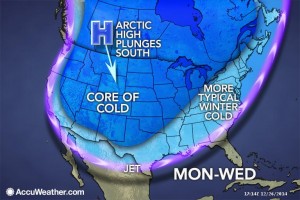On December 18, 1983, one of the severest Arctic cold snaps in modern day plunged into Texas. The mercury dipped below freezing at 7:00 am on December 18th and remained below freezing until 2:00 pm, December 30th, for a record of 295 consecutive hours of freezing/subfreezing temperatures. This of course made December 1983 the coldest December on record for Dallas/Fort Worth with an average monthly temperature of 34.8°F. This is 12.1°F below normal for the month and 4°F colder than any other cold December of record. The coldest temperatures recorded during this period was 5°F on December 22, 1983.
The area experienced a series of Arctic cold fronts beginning on the 15th, 18th, 21st, 24th, and 28th. The Arctic front on the 18th was the most significant. Cloud cover played a role in insolating the area, combined with a very low sun angle so close to the solstice, inhibiting any warming, and allowing the mercury to stay below freezing for several days. The cloud cover also kept temperatures from totally bottoming out, as had skies cleared totally, temperatures likely would have fallen below zero (in fact, Glen Rose, Tx did on the 30th with a low of -2°F). Therefore, this cold snap did not bring DFW its coldest low temperatures for December. That happened a few years later for DFW in December 1989, during another historic cold snap. The coldest temperature recorded was -1°F during 1989. However, from the 22nd through the 25th of 1983, the high temperatures failed to rise above 19°F with the coldest high reported on Christmas Eve of 13°F. This was the second coldest high temperature in DFW weather recorded history. This cold snap brought us 5 daily low temperature records that still stand to this day, and 6 daily high maximum low temperature records. Behind the Arctic front on the 24th, DFW set its all time highest barometric pressure of 31.06 inHg. The cold spell was preceded by a significant winter storm on the 15th and 16th of the month that brought a snowpack to North Texas, which aided in the severity of the cold. Many sites still had snow on the ground by the end of the month. Officially, DFW Airport reported two inches of snow with this event.
The deep freeze reached all the way into Northern Mexico, with severe freezes into the Lower Rio Grande Valley causing tens of millions of dollars worth of damage to the agriculture and farming industries. Thirteen people statewide, six in North Texas alone, were said to have lost their lives due to the cold. $1.5 million dollars damage was done to city pipes in North Texas alone, not including damage to homes and businesses from busted pipes. It was estimated that the damage to agriculture in North Texas was around $50 million.

